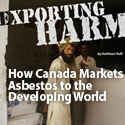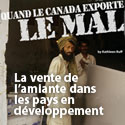Kathleen Ruff, RightOnCanada.ca
On August 10, 2016 the Board of Directors of the Journal of Occupational and Environmental Hygiene (JOEH) voted to retract an article, Airborne asbestos exposures associated with the installation and removal of roofing products, which the JOEH had published in June 2016. See statement by JOEH Editor-in-Chief, Mark Nicas of the School of Public Health, University of California Berkeley.
A number of scientists had called for the article to be retracted because of misrepresentation of data, distorted and misleading information, and erroneous conclusions that contribute to harming worker health and because of extreme undisclosed conflict of interest on the part of the JOEH editor, Charlie Blake, who reviewed and approved the article for publication.
The article was funded by Cardno ChemRisk, a consulting company that receives millions of dollars in consultancy services to companies facing asbestos litigation; the article was written by Cardno ChemRisk scientists, two of whom testify in court on behalf of companies facing asbestos litigation; the article was reviewed and approved by a JOEH editor, who receives millions of dollars for consultancy work for asbestos interests. In fact, at the time the article was being submitted and approved, both the JOEH editor (Charlie Blake) and one of the authors (John L. Henshaw) were being paid as consultants by the same company in the same asbestos litigation.
Months after the JOEH voted on August 10, 2016 to retract the article, the article is still, as of December 5, 2016, on the JOEH website.
The JOEH has for five months refused to answer any of the serious questions submitted to them concerning scientific and ethical improprieties in the article.
JOEH retracts its decision to retract the asbestos article
Four months after the August 10 decision to retract the article, Stephen Reynolds, President of the JOEH Board of Directors and President of Colorado State University, states that the JOEH board has now decided to retract its decision to retract the article. Instead the board will allow the Cardno ChemRisk authors to withdraw the article. Thus the JOEH will conveniently “disappear” the article and conveniently cover up the scientific and ethical misconduct.
The JOEH says it is allowing the authors to withdraw the article because the article should have been submitted as a Review article, rather than as a Column article and as a result, the manuscript did not receive the peer review to which a Review article is subject.
This explanation holds no credibility. From the time the problems were brought to the attention of the JOEH in July 2016, the journal has had five months in which to have the article peer reviewed and has not bothered to do so.
Pressure from vested interests
In a letter sent to the JOEH President and Board of Directors on September 25, 2016, scientists expressed their concern that the JOEH board was succumbing to pressure to retract its decision to retract the article. The writers stated: “We call on you as President and on the other members of the Board of Directors to act with integrity and implement the decision to retract the article that the Board took at its August 10 meeting. We encourage the JOEH not to abandon scientific and ethical standards and reverse its decision to retract the article in order to bow to pressure from vested interests and/or people with an obvious conflict-of-interest.”
It now appears that these concerns were warranted.
Protecting Worker Health?
A letter sent to the President and Vice-President of the JOEH on November 21. 2016 points out that the article and its flawed scientific information is being used on the asbestos lobby’s website (International Chrysotile Association) to help sell asbestos-cement roofing in the global South and cause harm to the health of populations overseas.
The JOEH is the official journal of the American Industrial Hygiene Association (AIHA), whose website proudly declares that the mission of AIHA is “Protecting Worker Health”. The JOEH states that it is “devoted to enhancing the knowledge and practice of occupational and environmental hygiene and safety by widely disseminating research articles and applied studies of the highest quality.”
The indifference to harmful scientific misinformation and improper conflict of interest that the JOEH and AIHA are demonstrating is in direct violation of the mission and standards they claim to uphold.
It is because of harmful scientific misinformation and improper conflict of interest, such as the JOEH and AIHA have exemplified for the past five months, that the asbestos industry succeeds in selling two million tons of asbestos each year and placing it in the homes and schools of populations in the global South, where it will cause epidemics of asbestos-related diseases for decades to come.



Mon, Dec 5, 2016
Asbestos